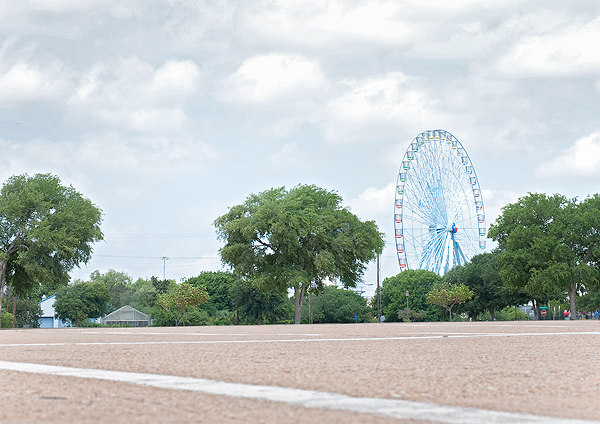Using data available on neighborhoodscout.com, the AOL website DailyFinance recently published a list of the 25 most violent neighborhoods in America. Dallas is home to neighborhoods No. 9 and No. 12. Baltimore, Kansas City, and Memphis also had two neighborhoods on the list. Chicago had four. Both Dallas neighborhoods lie immediately south of Fair Park, adjacent to each other in ZIP codes 75210 and 75215. If you were to live there for one year, you’d have a 1 in 8 chance of being a victim of violent crime.
What’s going on here? We know that crime is less likely to occur in an area when the flashlight of human activity is shining on it. Crime follows disinvestment. But what causes that disinvestment? In the case of Dallas’ two most violent neighborhoods, I think parking lots are the culprit.
In the late 19th century, there were two competing fairs in Dallas. A deal was struck to merge the two in a Beaux Arts-style park of tree-lined allées. Ultimately, it was a speculative land deal, an effort to push the city eastward and establish it as a railroad hub. In 1936, the park was expanded for the Texas Centennial celebration, and the art deco buildings that exist today were built. During the 76 years since, a variety of large-scale public works projects—most notably I-30—have severed Fair Park and its adjacent neighborhoods from the rest of the city.
In his book Linked: How Everything Is Connected to Everything Else, Albert-László Barabási writes that all of science has been about reductionism, dissecting organisms to study the parts of a greater whole. But we’re not very adept at going in the other direction. It’s much harder to build a frog than it is to take it apart. The same can be said for cities. Specialists understand their little pieces of the city puzzle the way we understand anatomy. Architects assemble increasingly complex buildings. Engineers build increasingly exotic overpasses and bridges. But few know how these systems interrelate. We’ve even zoned cities in a reductive fashion. Euclidean zoning (so named for the town in which it was first applied, Euclid, Ohio) breaks a city into chunks, each with a regulated use.
But cities are more complex than that. The whole is greater than the sum of its zoned chunks. The whole is a network that functions well only when its connections—the route between you and your destination, your wants and needs—are robust. Too often we impede these connections. We cut off local streets with interstate highways. We build at-grade railroads. The result is slow, steady, inevitable disinvestment. This is the story of Fair Park.
Bill Hillier, a professor at University College London, invented Space Syntax, a mathematical model to measure the complexity of street and block networks. He has found a direct relationship between land value and highly interconnected places. In the opposite direction, Hillier’s model, applied to London, showed a strong correlation between physically isolated places and disinvestment and lack of opportunity.
I used Hillier’s software to create a model of downtown Dallas and surrounding areas. As expected, the Fair Park area scored poorly. Despite the potential attraction of an MLK link from Fair Park to the Trinity, developers haven’t come. Fair Park remains isolated.
So how can the connections be improved, and how can we turn on that flashlight of human activity? Fair Park is defined not by park but parking. There are 47 acres of surface lots lining the southern boundaries of the park, right where those two dangerous neighborhoods sit. Imagine all that asphalt and concrete replaced by 3,000 new residents walking dogs, jogging, picnicking, patronizing local businesses. Fair Park has two nearby DART stations. We have to think about the area as a place to commute from rather than just a destination to ride the train to.
The city owns this asset. It sits dormant most of the year, waiting for the State Fair of Texas to roll around and the parking spaces to fill up. In the meantime, those surface lots suck up maintenance dollars, and they foster disinvestment and violent crime. It’s time to stop letting Big Tex run our city.
Write to [email protected].






